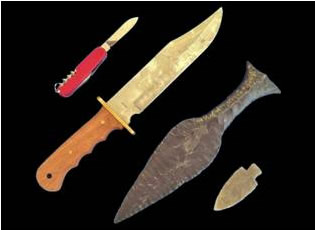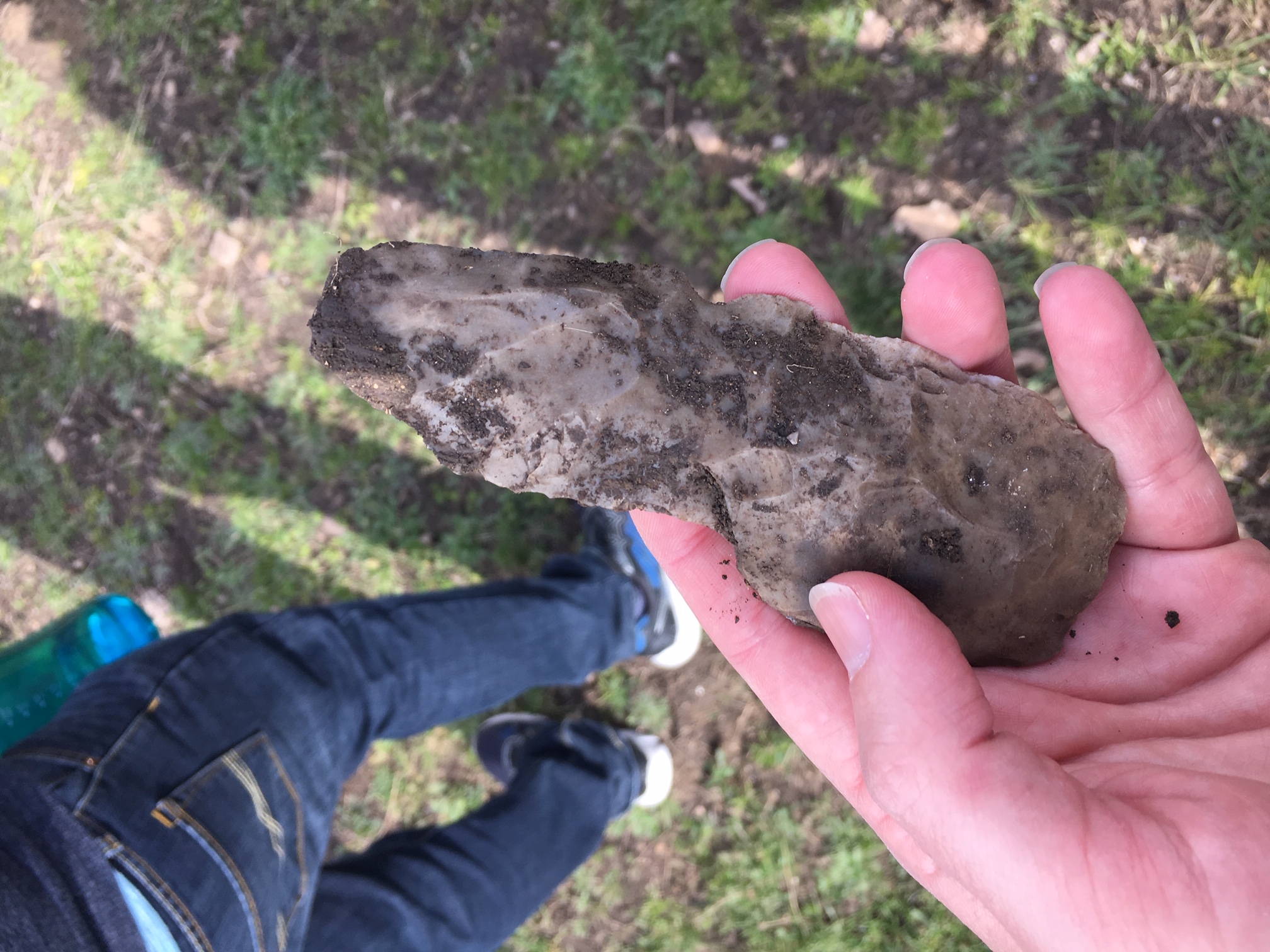Today’s guest post was written by Dr. Gus Costa, Geoarchaeologist at Rice University and Paleoarts Educator/Owner of The Flintstone Factory
The ascent of humankind is an unlikely story of a clawless, small-toothed primate prevailing in a brutish world of horrific beasts. How did our ancestors compete with lions, tigers and bears? More importantly, how would you cope with similar hardships in the wild without modern amenities? Just think camping without any of your essentials. That’s right! No air conditioned RV or battery-powered margarita maker. Sounds pretty miserable, huh?
Humans are addicted to material culture. We need our “stuff.” We need it so badly that we would die without it. Even the most austere, anti-materialist Tibetan monk needs a coat and shoes when he goes outdoors. Thomas Carlyle (1884) said it best, “man is a tool-using animal…without tools he is nothing, with tools he is all.” Our dependence on stuff as a means of adaptation is what makes us special. Yet this “all or nothing” strategy also makes us particularly vulnerable, especially if many of us cannot make what we need to survive. Modern people are very accomplished tool users, but rarely are we tool makers. Even the contemporary hunter-survivalist culture is inherently consumerist. What happens to human self-reliance when all the fancy bells and whistles are taken away?
The Discovery Channel show “Naked and Afraid” provides an excellent case in point. This TV program follows two survival experts who are tasked with living in the wild, completely nude for 21 days! Participants are allowed to bring one helpful item each. As one would expect, somebody always brings some kind of cutting tool (survival knife, machete, axe etc.). This TV show clearly demonstrates that: 1) even survival experts probably wouldn’t last long in the wild without any gear and most importantly, 2) a cutting implement is the most essential item a human can possess in the wild.
For more than 99% of human existence, stone tools (knives, hammers, axes, spear-tips, arrowheads, etc.) have provided a critical advantage to an otherwise poorly equipped animal. Our distant ancestors may have been naked, but they weren’t afraid because they knew how to make stone knives and other essentials needed for survival.

Factory-made modern cutting implements versus hand crafted, all natural paleo-cutlery (Image Credit: Gus Costa, The Flintstone Factory
Stone tools are part of everyone’s heritage. Regardless of who you are at some point in the past your ancestors made and used stone tools. It’s an international tradition, not just something that Native American used to do. The oldest artifacts known are 2.6 million year old stone tools from Africa. Yet several contemporary peoples still employ stone tools in traditional activities. In short, flaked stone technology is the most persistent human practice known and was the essential skill largely responsible for the survival of our species………. So why don’t we know more about it?
The Stone Age is the longest and most mysterious phase of the human story largely due to the durability of stone relative to other biodegradable materials. Items made of perishable materials (wood, bamboo, bone) were surely important, but these organic clues have decayed and vanished over the millennia. Much like diamonds, stone tools are forever. Stone tool “fashions” have also changed through time and from place to place, so they can be used by scientists as chronological markers in addition to shedding light on ancient human behavior.
Flaked stone tools are made by fracturing naturally occurring rocks with glass-like properties (brittle, hard and uniform silica-based stones like cherts, flints and obsidian). This process is called knapping, a word of Germanic origin meaning to break by a sharp blow (not to be confused with siesta style napping). Knapping was a cultural universal among all human populations until about 8,000 years ago, when metallurgy emerged and metal artifacts replaced stone tools.
Despite being a major caveman past time, knapping is more complex than most people realize. Locating the proper type of stone requires geological and geographical knowledge. Knapping also demands a basic understanding of physics. The trick behind knapping is the successful manipulation of a “hertzian cone”—a type of fracture commonly seen in car windshields. Hertzian cones are produced because force propagates equally in all directions in uniform materials. Just like a water drop in a pool – energy radiates in a symmetrical manner through glassy substances. Controlling the direction and magnitude of this phenomenon allows the knapper to “sculpt” stone into a finished tool, by using a variety of techniques and knapping tools.
Direct freehand knapping with a stone hammer is the most basic approach, although antler, bone or wood may also be used to remove stone flakes or chips. By the later stages of prehistory, knappers discovered that focused pressure with a pointed implement was an effective way to finish and sharpen tools. Arrowheads and other projectile points were often completed by pressure flaking with deer antler tines.

Tools of the trade. Traditional flint knapping tools Left hammerstones, Right Deer antler and wooden batons. Below Large composite pressure flaker. (Image Credit: Gus Costa, The Flintstone Factory)
There are many other intricacies to the lost art of knapping. Replicating prehistoric stone tools is extremely powerful and enlightening activity that is much more difficult than one might expect. After more than a decade of knapping and a Ph.D. in Paleolithic archaeology, I have not yet progressed far beyond the Neanderthal stage of technical complexity!
A two million year old Early Stone Age knife is the most rudimentary technology known. It’s so easy that a caveman could do it. In fact, even captive chimpanzees have learned to make these basic tools! But could you? Are you smarter than your prehistoric ancestors?
If you enjoy history, science, technology, art, and breaking things – I invite you to put your highly evolved brain to the test by joining me on Wednesday December 4th for our first HMNS “School of Rock.” This HMNS Adult Education class (must be older than 16) will teach you the prehistoric skills needed to master the ancient art of stone tool making. Discover how antler, stone and bone can be used to fashion a paleo-survival knife through proper percussion and pressure methods. Learn how to make an arrowhead by pressure alone and a simple stone knife using traditional hand tools. Your lithic art is yours to keep for your collection. Participants should wear long pants and close-toed shoes. All materials, tools, and safety equipment will be provided by The Flintstone Factory.
Let’s see you test your wit and grit against that of your “primitive” ancestors!
ADULT FLINT KNAPPING CLASS
“Reinventing Stone Age Tools”
Wednesday, December 4, 6 p.m.
Tickets $80, Members $65
Paleolithic archaeologist Gus Costa will teach the prehistoric skills needed to master the ancient art of stone tool making. Using traditional hand tools, craft a simple stone knife that is yours to keep for your collection.
For tickets, click here or call 713.639.4629.








